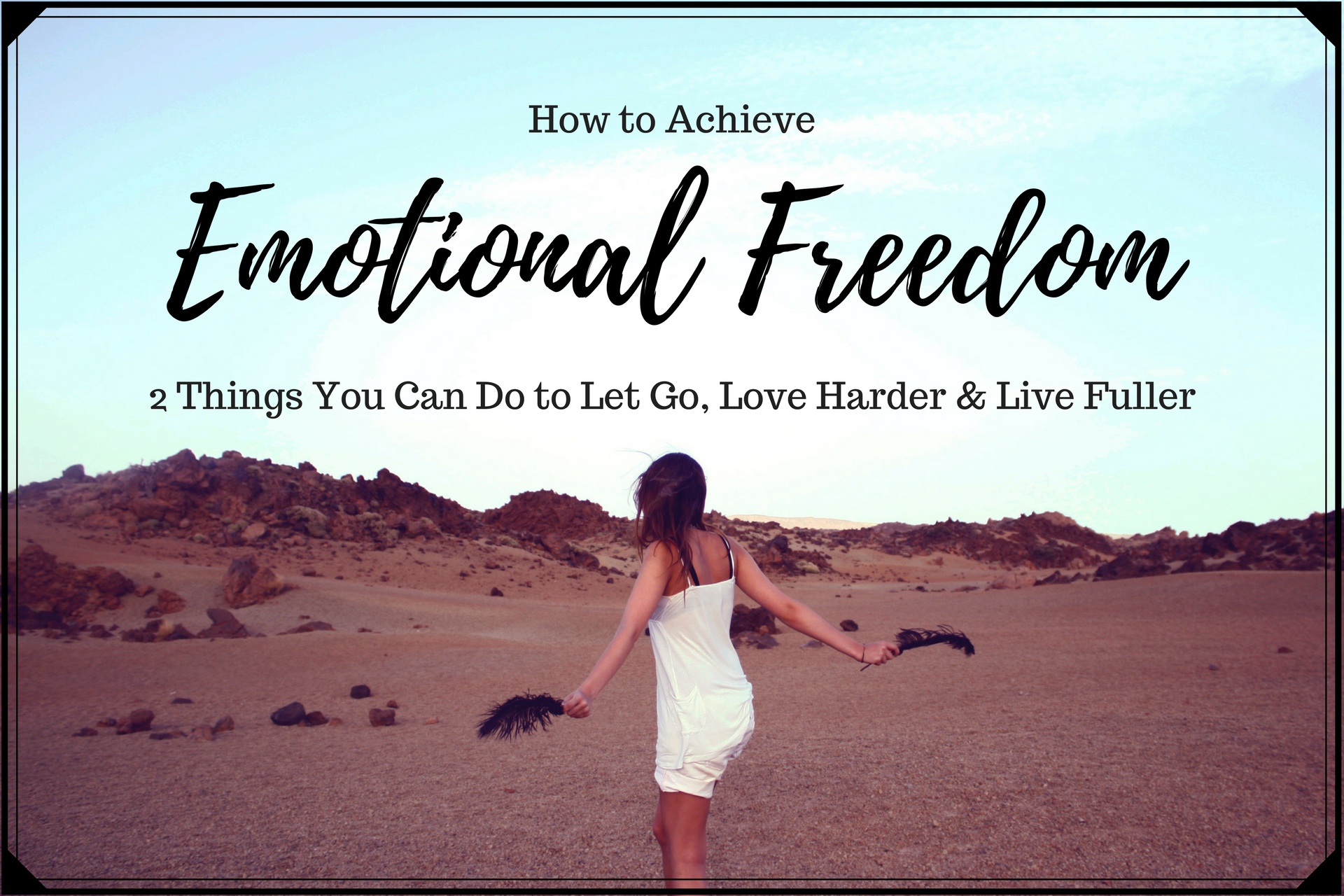Over 40 million adults are diagnosed with some type of anxiety disorder, including panic disorder, post-traumatic stress disorder (PTSD), social anxiety, and generalized anxiety (1).
I was one of them.
For a long time I had trouble focusing and “clearing my mind” of anxious thoughts. I worried about the future. I replayed past events over and over in my head. I thought about what I could or should have done differently, questioned why, and held on to negative emotions that kept me in bondage and prevented me from moving forward.
The result?
A constant state of restlessness, irritability, worry, emotional fatigue, and sleeplessness.
I spent the better part of a year studying how to get out of that place where my past dictated my present, my circumstances dictated my mood, and the words and actions of others dictated my self-worth. I chose to stop focusing on what I couldn’t control and start focusing on what I could. I discovered that I had the ability to control my thoughts and the responsibility to “take captive every thought to make it obedient to Christ” (2 Corinthians 10:5).
One of the largest contributors to anxiety and depression is a lack of emotional freedom. Emotional freedom refers to our ability to liberate ourselves from worry, fear, resentment and other emotions that destroy our relationships with others and our ability to lead a God-shaped life (2).
IN ORDER TO ACHIEVE EMOTIONAL FREEDOM, WE MUST DO TWO THINGS.
1. CULTIVATE A STATE OF MINDFUL AWARENESS.
Being mindfully aware means that we can recognize what we are feeling, accept responsibility for how we are feeling, and take control of our emotions before they take control of us. It’s more than thinking, “I feel overwhelmed,” and then just accepting the fact that we feel that way because our life is jam-packed with commitments, responsibilities, and never-ending to-do-lists. It’s about taking a moment to pause, facing the reality of why we feel that way, and allowing the undesired emotion to spur the desired response and positive change (2). The word “cultivate” is key because, like any other skill, mindful awareness must be practiced and developed over time. As we become able to use our emotions to better understand ourselves and to grow, we move toward achieving emotional freedom.
2. VIEW OUR EMOTIONS AS TOOLS FOR TRANSFORMATION.
Rather than merely accept how we are feeling or refuse the negative emotion, we can choose to replace it with what we need in that moment – to transform it in a way that it becomes “obedient to Christ.” In that moment when we feel scared, we can choose to have courage. In that moment when we feel lonely, we can choose to seek comfort and companionship. In that moment when we feel overwhelmed, we can choose to focus on one thing and not let the cares of the past or concerns about the future spill over into the “right now.”
When we are angry, we can choose to show compassion and understand that hurt people hurt people. How we respond to others can either perpetuate the anger or dissolve it.
When we are mistreated, we can choose to extend forgiveness and understand that holding on to hurt actually hurts us more than the other person. When we choose to forgive, we can transform our hurt into healing as we extend the same grace that God extends to us to others.
Frustration can be replaced with patience, anxiety with calmness, and worry with peace when we choose to view our emotions as opportunities for personal and spiritual growth.
While there is a biological component to our emotions, such as an increase in blood pressure and release of hormones, there is also a psychological and a spiritual component (3). When we train our minds to develop a state of mindful awareness (psychological) and use prayer as a vehicle to transform our negative thoughts and behaviors into positive ones (spiritual), we can reverse the biological symptoms associated with those emotions.
The overwhelmed mom who feels her body temperature rising, her blood pressure increasing, and is on the brink of “losing it,” can choose to Stop, Pause, and Pray. She can Stop what she’s doing, Pause to breathe and become mindfully aware of her situation, and Pray for what she needs in that moment (e.g. self-control, focus, peace of mind). This simple practice helps her center herself and calm her emotions so that her blood pressure and body temperature return to normal. It enables her to rise above what she’s feeling, learn from it, and even benefit as a result of it.
In bringing herself to a place of mindful awareness, she is able to identify what she is feeling and the triggers that lead to that emotion. In identifying her triggers, she is able to develop proactive strategies to sidestep those triggers and coping mechanisms for transforming “overwhelmed” into positive action. In embracing her state of “overwhelmed” and redirecting it to a place of growth, she is able to stay in focused and in control even when her situation seems out of control simply by training her mind to think differently (4).
“You were indeed called to be free, brothers and sisters. Don’t turn this freedom into an excuse for your corrupt nature to express itself. Rather, serve each other through love…Live your life as your spiritual nature directs you. Then you will never follow through on what your corrupt nature wants…
Now, the effects of the corrupt nature are obvious…hatred, rivalry, jealousy, angry outbursts, selfish ambition, conflict, factions, envy…and similar things…But the spiritual nature produces love, joy, peace, patience, kindness, goodness, faithfulness, gentleness, and self-control…Those who belong to Christ Jesus have crucified their corrupt nature along with its passions and desires. If we live by our spiritual nature, then our lives need to conform to our spiritual nature.” (Galatians 5:13,16,19-25 God’s Word Translation)
Call to Action: What thoughts or emotions do you need to “take captive” and make “obedient to Christ” so you can live by your spiritual nature and pursue a God-shaped life? How might you apply the strategies presented here to transform negative thoughts and emotions into positive change?
Bonus Content: For a free printable bookmark with “go-to” Bible verses for achieving emotional freedom, please click here. Enter your email address and I’ll send it your way!
Looking for More Information? Take the quiz, “Are You Emotionally Free?” to assess your level of emotional freedom and/or check out these resources below to grow in this area:
Battlefield of the Mind: Winning the Battle in Your Mind by Joyce Meyer
Emotional Freedom: Liberate Yourself from Negative Emotions and Transform Your Life by Judith Orloff
Living Beyond Yourself: Exploring the Fruits of the Spirit by Beth Moore
References:
- Anxiety and Depression Association of America (ADAA). (2016, August). Facts and Statistics. Retrieved March 8, 2017 from https://www.adaa.org/about-adaa/press-room/facts-statistics.
- Oroff, Judith, M.D. (2009). Emotional Freedom: Liberate Yourself from Negative Emotions and Transform Your Life. New York, NY. Three Rivers Press.
- Orloff, Judith, M.D. Positive Energy Emotional Freedom Package. Retrieved May 8, 2017 from http://www.drjudithorloff.com/ef-gifts/positive-energy-emotional-freedom-package.pdf.
- TerKeurst, Lysa. (2012).Unglued: Making Wise Choices in the Midst of Raw Emotions. Grand Rapids, MI. Zondervan.
- Meyer, Joyce. (1995). Battlefield of the Mind: Winning the Battle in Your Mind. New York, NY. Faith Words.
- Moore, Beth. (1998). Living Beyond Yourself: Exploring the Fruit of the Spirit. Nashville, TN: LifeWay Press.






One thought on “How to Achieve Emotional Freedom – 2 Things You Can Do to Let Go, Love Harder, and Live Fuller”